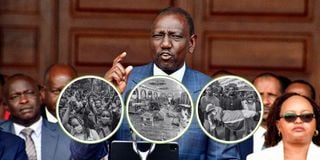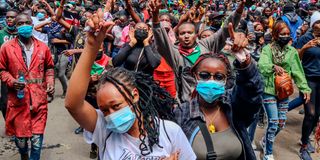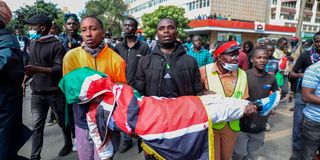
President William Ruto addresses the nation at State House, Nairobi on June 26 2024 when he announced the government’s plan to withdraw the contentious Finance Bill 2024.
A “reverse baptism” it was. A baptism by fire, or of whatever. But it was a process that took in an affable politician and brought out a vicious one.
For Kenya’s second President Daniel arap Moi, the “reverse baptism” is widely believed to have happened after the botched August 1, 1982 coup.
For President William Ruto, the eventful day of June 25 when Parliament was invaded and part of it set on fire by protestors is quickly shaping up as that moment.
After the failed coup, Moi unleashed a side of him that had never been seen since he took power in 1978, turning into a heavy-handed ruler who was ruthless against the Opposition and government critics wherever they were. Torture, assassination and excessive espionage became part of his playbook.

Yong Kenyans protest on Kenyatta Avenue in Nairobi on June 25, 2024.
For Dr Ruto, events following the “Occupy Parliament” protests are continually showing that he is not the same person Kenyans had known since he took office in 2022. It started with the terse statement he read on the evening of the Parliament invasion.
“Today, Kenya experienced an unprecedented attack on its democracy, rule of law and the integrity of its constitutional institutions. An otherwise legitimate expression of the fundamental rights and freedom of assembly, demonstration, picketing and petitioning of public authorities, by a section of law-abiding citizens of the Republic of Kenya, was infiltrated and hijacked by a group of organised criminals,” Dr Ruto charged.
Despite assurance that he was in charge of the nation, analysts say the president “lost governance mojo” even making concessions including rejecting the contentious Finance Bill, 2024.
This stems from challenges of diminishing political influence, unmet campaign promises, youth unemployment, economic difficulties and internal political tensions within the government.
The youth protests tested President Ruto’s leadership, contributing to perceptions that his once-strong momentum had faltered.
Political analyst-cum-governance expert Javas Bigambo says the protests “marked a political turning point for the President”. “He elected to earn public confidence and attention, and not the attention of politicians, who had for long made the President ride the wave of assumptions,” Mr Bigambo told The Weekly Review.
Before the demonstrations, Dr Ruto made numerous overseas trips. However, since June 25, he made his first trip outside the country to Rwanda on August 11.
The anti-government protests that began on June 18 with calls for the rejection of the Finance Bill 2024 and later morphed into calls for his resignation, grounded the President since his return from a G7 trip in Italy before returning to the country on June 15, 10 days before the invasion of Parliament.
The President’s State House engagements also reduced drastically. Between January and June 17, he held at least 100 meetings at State House compared to 62 from June 18.

Broken furniture inside the dinning hall at Parliament Buildings after protesters stormed and vandalized Parliament on June 25, 2024.
The demonstrations also contributed to the President’s strained relationship with his deputy Rigathi Gachagua, who has since been impeached. A section of Gachagua’s aides were grilled by security personnel, including two MPs from Nairobi – James Gakuya (Embakasi North) and Benjamin Gathiru Major Donk (Embakasi Central) over links to the protests.
Gachagua had questioned why the National Intelligence Service (NIS) led by Director-General Noordin Haji did not provide prior intelligence to the President before the protests. “At one point they say it was Gachagua who sponsored the protests, sometimes they accuse Uhuru Kenyatta and in some instances the neighbouring countries, so which is which?” Gachagua posed days before he was impeached.
President Ruto later dismissed all Cabinet Secretaries and the Attorney-General, Justin Muturi, in response to the anti-government protests, even slowing down his local travels. Only Prime Cabinet Secretary Musalia Mudavadi was spared.
Facing internal pressure from his own government following a strained relationship with his deputy, Dr Ruto opted for a “broad-based” administration, reaching out to his 2022 presidential opponent Raila Odinga for a working arrangement.
Odinga, now Kenya’s candidate for the chairmanship of the African Union Commission (AUC), came in handy to provide a buffer to Dr Ruto’s administration, nominating his top ODM party officials for appointment to the Cabinet.
Then-ODM deputy party leaders Hassan Joho and Wycliffe Oparanya, National Chairman John Mbadi, Secretary of Political Affairs Opiyo Wandayi, and member of the party’s elections board Beatrice Askul joined the Cabinet.
“Anyone thinking that Dr Ruto learnt anything from the Gen Z protests or rebellion is deluded. He is the same today and yesterday, maybe tomorrow,” says political analyst Martin Oloo.

Demonstrators carry the body of a protester who was shot dead at Parliament Buildings during anti-government protests in Nairobi on June 25, 2024.
“He still believes in politics of exclusion, believes in himself and thinks and works around himself. Gen Z protests only helped him to be more repressive and he is now doing things and dealing with opponents without any sympathies.”
Bigambo argues that the President “has become more intentional about purposive coalition building, curating internal party flaws and more goal oriented governance.”
“The President is overtly keen, observably, on delivering on each manifesto commitment he made,” he says.
Dismas Mokua, an analyst, says the June 25 events created an environment for the President to identify fair-weather friends.
“Fair-weather friends are taking a backseat, with trusted friends joining the sanctum. The Gen Z demonstrations presented President Ruto a lemon that he soon converted to a lemonade. In the words of Rahm Emmanuel, the top US public servant, President Ruto did not let the crisis go to waste.”
The President, he says, implemented fundamental reforms and abandoned some initiatives like Chief Administrative Secretary (CAS) appointments that under normal circumstances would invite political penalties. The Gen Z demonstrations, he adds, also created an environment where public participation is no longer ceremonial nor mechanical.
“Citizens’ interests have to be mainstreamed to policy development. Failure to capture citizens’ interests and aspirations can potentially lead to policy collapse.”
On the economic front, Dr Ruto proposed budget cuts and additional borrowing in roughly equal measure to fill a Sh346 billion budget hole caused by his withdrawal of planned tax hikes in the face of nationwide protests. He asked Parliament for spending cuts totalling Sh177 billion for the fiscal year beginning July 2024 and announced that the government would increase borrowing by about Sh169 billion.

Members of the public protest outside Parliament Buildings in Nairobi on June 25, 2024.
Apart from suspending the decision to fill the CAS posts, the President said 47 State corporations with overlapping and duplicative functions would also be dissolved, resulting in the elimination of their operational and maintenance costs, and their functions would be integrated into the respective line ministries.
The opposition has accused President Ruto of ruling with an iron fist, and that despite his assurance to address such human rights concerns, there appears to be no end in sight to arbitrary abductions, signalling a growing alarm over the continuation of forced disappearances and security crackdowns. Gachagua had been vocal over the vice that has now become rampant in parts of the country.
During a press conference a day before he was ousted by the National Assembly, Gachagua accused the Kenya Kwanza administration of State-sponsored abductions and extra-judicial killings. He expressed discontent with his own government, signalling internal rifts.
“Despite the police misleading the President to say that there are no abductions, you all know, you have evidence on video and that’s what I commented on and said it is wrong,” he said. “I’ll say what is wrong when it happens and even though I am compelled by the principle of collective responsibility, I’ll continue to do so only those decisions that are constitutional and within the rule of law.”
On Wednesday, Azimio la Umoja One Kenya principals Kalonzo Musyoka (Wiper), Eugene Wamalwa (DAP-K) and Jeremiah Kioni (Jubilee) accused President Ruto of reverting Kenya to a police state.
“Dr Ruto should resign with immediate effect for violating his oath of office ‘to be faithful and bear true allegiance to the public of Kenya’, and that he would ‘obey, preserve and protect this constitution of Kenya,” said Musyoka.
“The President carries the biggest responsibility for police phone spying, State-sponsored abductions, hijackings, and extrajudicial killings.”
The recent “abduction” of human rights defender Boniface Mwangi, and the police’s failure to press charges against him, has only cast a spotlight on the Ruto administration’s persistent crackdown on civil liberties.
“The unconstitutional abductions have, since the Gen Z protests, resulted in lengthy illegal detentions like in the case of Bob Njagi and the Langton brothers Aslam and Jamil, or death as in the case of many who include the university student leader, Denzel Omondi, who was murdered and body recovered in a quarry or the more recent abduction, and the murder of John Njuguna Kuria of Kapenguria,” says Narc-Kenya leader Martha Karua.
These, Ms Karua says, are dark reminders of the regime’s determination to silence dissent. The Kenya National Civil Society Centre Executive Director Suba Churchill also faults the government, noting that the State is entirely to blame for the wave of unprecedented gangland style abductions and killings.
“Individual citizens and criminal elements seem to have taken the cue to join the fray, engaging in similar crimes with impunity after realising that with the State deeply steeped in the vice and its agents getting away with gruesome murders, there is no one to hold them to account,” he offers.
While addressing ODM party delegates in Mombasa recently, Odinga said the country was yet to have a national conversation to address issues bedevilling it, which have caused public uproar.
“We need a national dialogue, a national convention to discuss the issues ailing the country, some of them which we raised ourselves and others by youth during this year’s demonstrations. That conversation has not taken place.”











